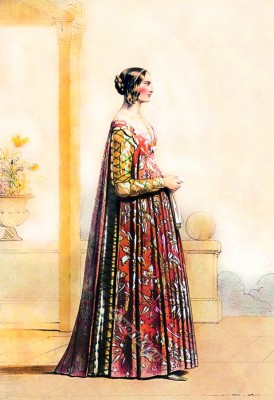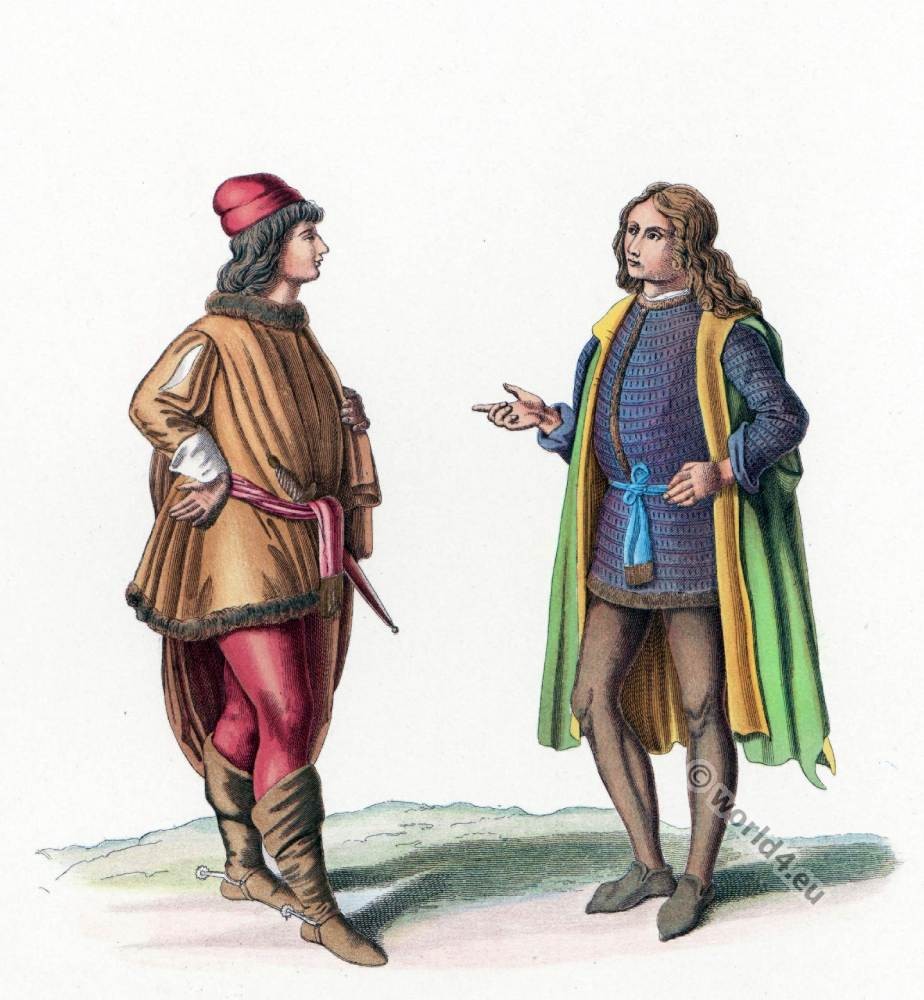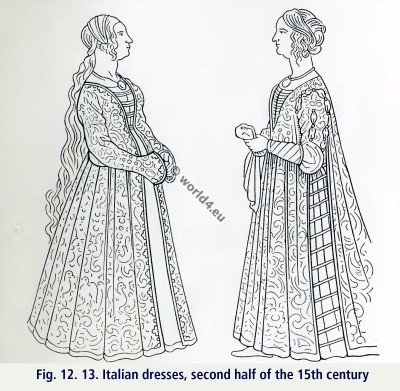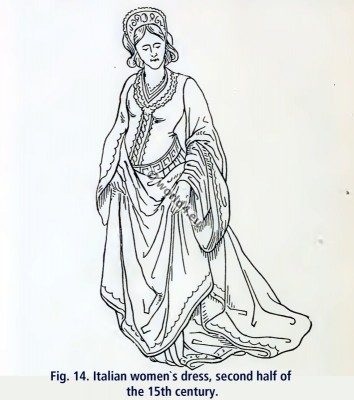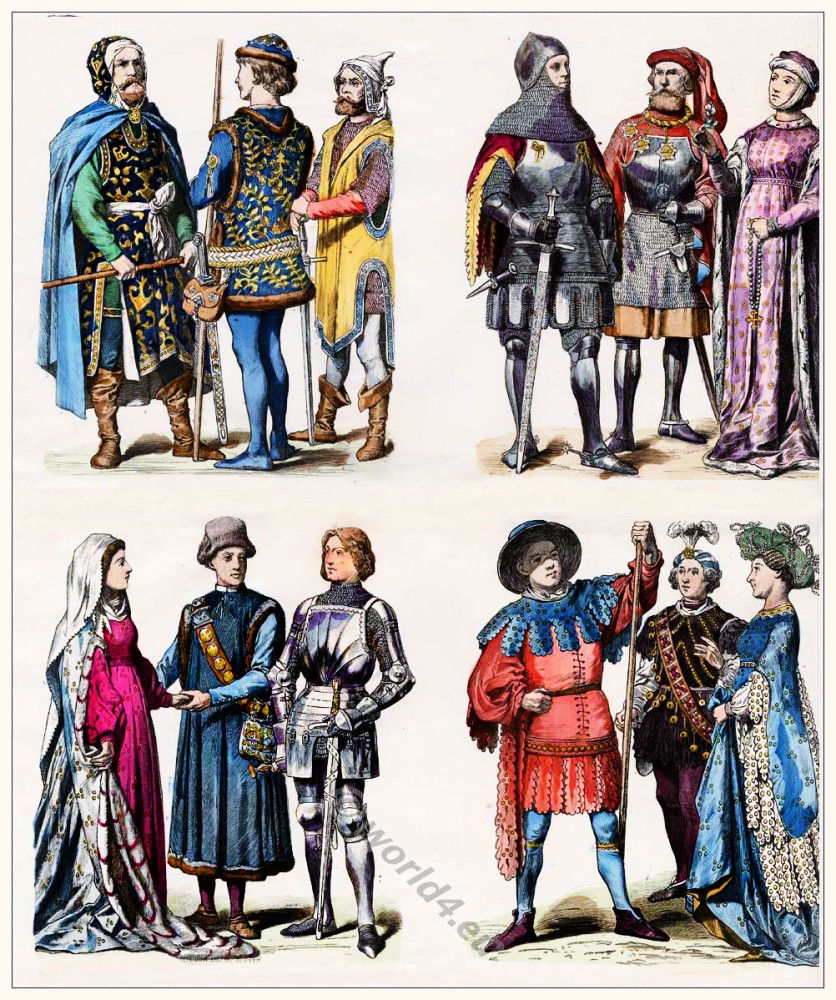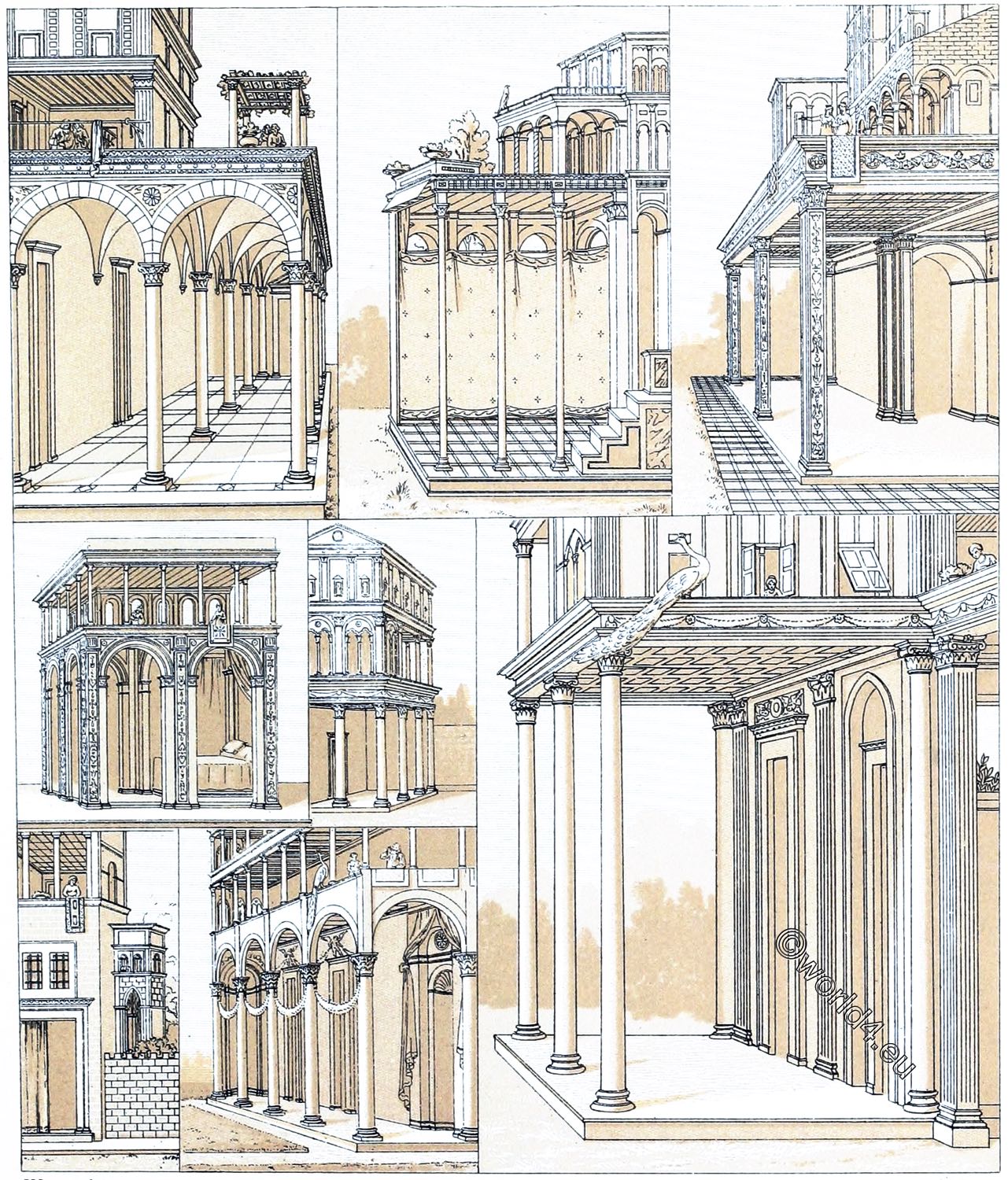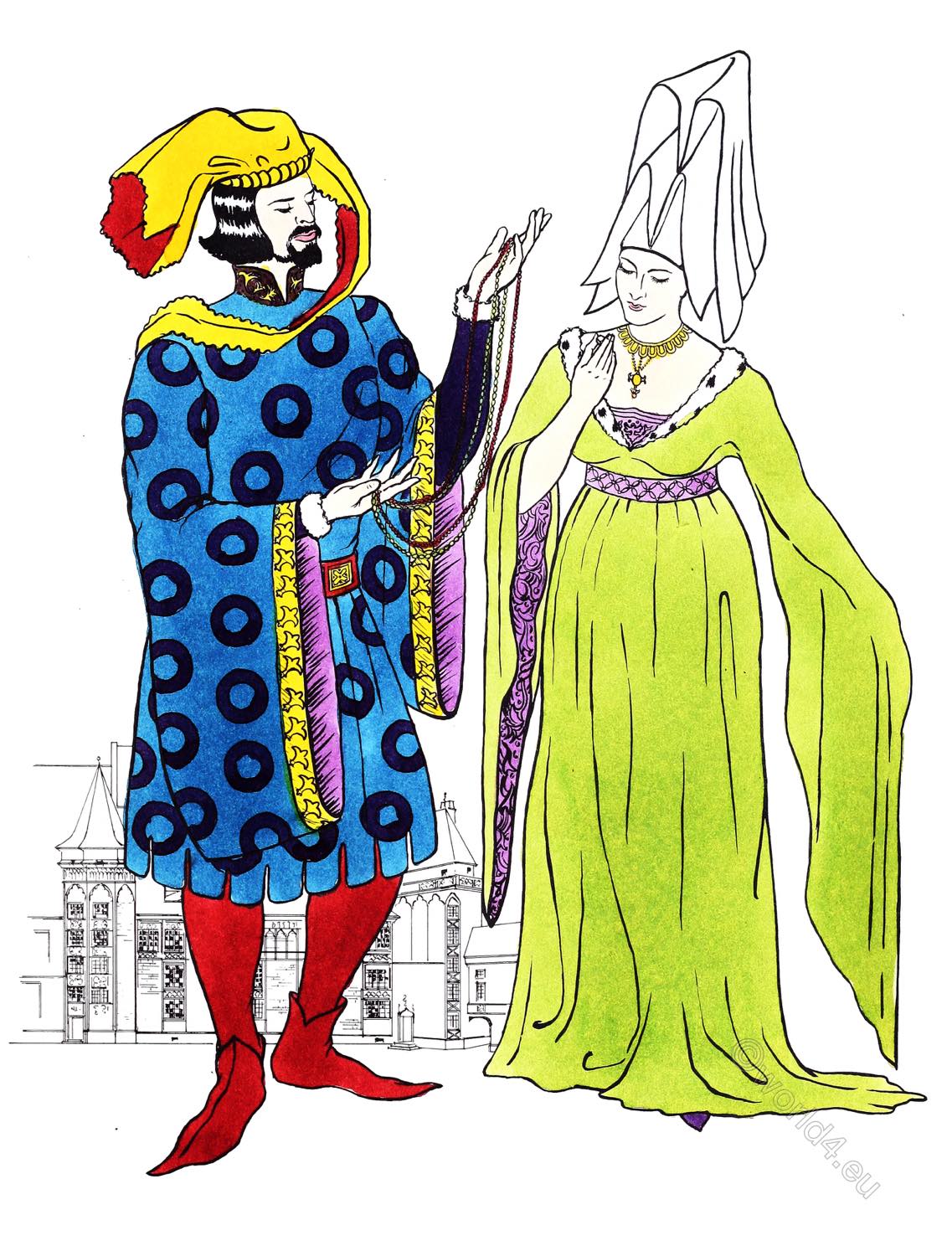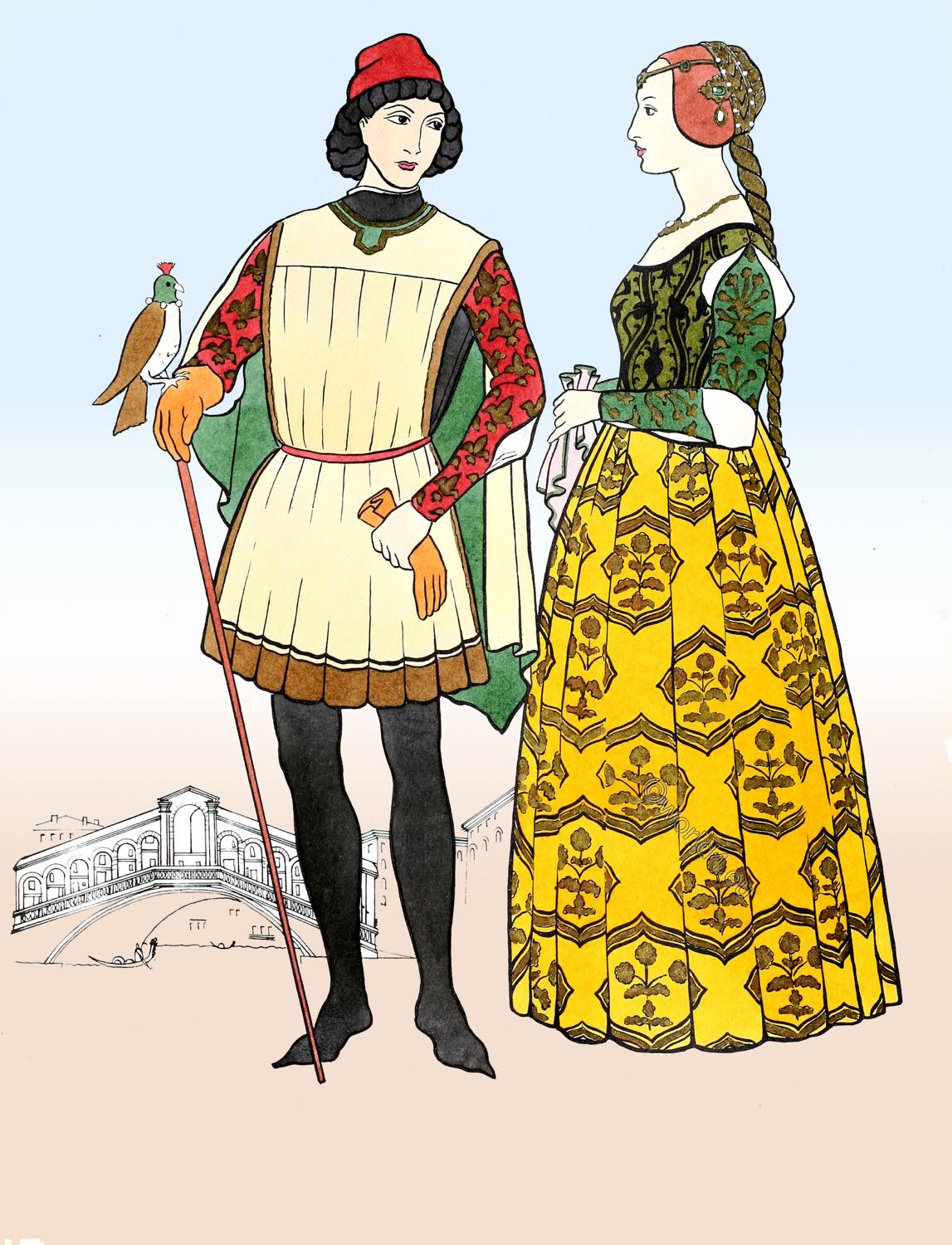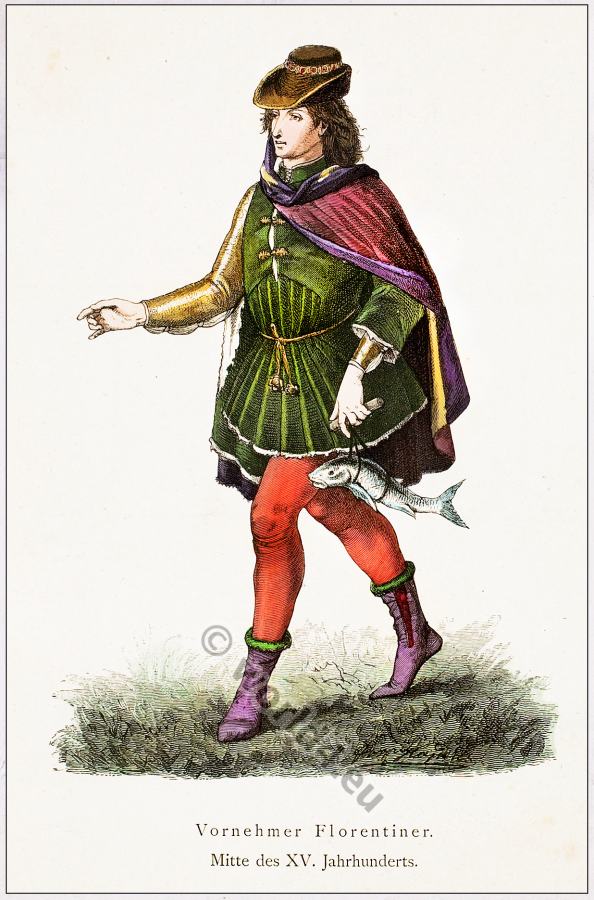
Top row left: Dress of the Viktor Pisani, Supreme Commander, Admiral of the Venetian fleet in 1380. Clothing of an Italian pages and Neapolitan knight in full armor with a sword. Right: Italian soldiers, archer and knights in armor.
Bottom row left: Dresses of a young Italian woman, Italian nobles and women of Siena. Right: Clothing of a young man, Senator of Rome and noble Venetians.
Italian fashion history. Middle ages to Renaissance.
In the fifteenth century Italian dress exhibited the same variety as that of France, England, and Germany. Still, in spite of foreign influences, it preserved its own peculiar national character, and was distinguished from German dress by far more lavish adornment and by the richness of the materials used.
In Italy, as in other countries, numerous enactments were promulgated with the object of restraining the ever-increasing luxury in attire, but these were just as unsuccessful in Italy as elsewhere.
Men’s Dress.
For the short over-dress the styles that prevailed in the fourteenth century continued into the fifteenth. These were either close-fitting all the way down, or widened from the shoulders down, but changes in shape and finish greatly altered their appearance. Fur trimming was still in favor, and was displaced only for a brief period by points, which appealed to Italian taste also.

The greatest change was in the sleeves. Fashion prescribed no special styles, and every one was left free to follow his own taste. The first changes in the shape of the coat that the fifteenth century saw were unimportant. The coat was much shorter. Although the high neck remained fashionable for a time, the neck was now mostly low, cut in a deep V-shape both back and front, allowing the underdress to be seen. Thus the slit at the breast, which came down to the waist, and could be buttoned, became unnecessary.
During the first half of the fifteenth century close-fitting coats went entirely out of fashion. Coats were cut away above the hips and a pleated skirt sewn on, the seam being hidden by a girdle buckled over it. Even with the coats that widened gradually the girdle was now worn higher up, to keep in place the pleats of the coat. In most cases, however, these pleats were sewn down when the coat was made.
This last style of coat, the sleeves of which were long and full, or tight and half-length, or long, wide, and pendent, was mostly open at both sides from the foot to the hips, and had all the edges trimmed with fur. These coats (Fig. 1.), widening downward, were made to fit the body closely; the skirt was sewn on in such a manner that the pleats in it reached into the upper part in the shape of thick, pointed scallops (Fig. 2.).
The skirt was sewn to the body of the coat as follows. In the bottom edge of the upper part was cut a long, narrow gusset for each pointed scallop. The upper edge of the skirt, which was straight and wide, was shaped into an equal number of scallops, as long as the gussets, but much broader. These were sewn to the top of the skirt so that each formed a roll that increased in width downward. Each of these rolls represented a pleat whose size varied with the shape of the scallops.
The coat was then arranged for buttoning down to the abdomen. Besides these somewhat long coats, the Italians also wore the short, close-fitting German jacket, but with wide, slashed sleeves. In ceremonial dress or dress indicating distinction the long over-garments continued almost exactly as they had been in the fourteenth century.
They were, if anything, even longer, and open all down the front. The increase in width began only at the breast, and if twice or four times the width of the material was not enough, the necessary width was obtained by sufficiently large gussets at the sides. The sleeves of the long over-coats were of all kinds. They were mostly long and, especially in front, very wide. Sack sleeves were also worn, the opening for the hand being at the wrist and as tight as possible.
Fur trimming continued in the 15th century. When, during the second half of the 15th century, long, wide over-coats again became the universal fashion in Italy, as elsewhere, they showed a great variety of shape, due more to small changes of detail than to any great change of general cut. The cut of the tunic was, strictly speaking, the same as before.
Usually it reached to the feet, sometimes to the ankles, and sometimes only half way down the calf. The width showed similar variation, but the coats were never so tight that the wearing of a girdle did not cause numerous folds round the body. A girdle was not always worn, but when it was used it was a richly ornamented leather belt worn obliquely, or a thick cord, or a long shot silk sash. Sometimes the coat was fitted with a small strap, through which the cord or belt was passed and tied according to taste.
There were other changes in these long over-garments. They were either closed all down the front or had merely a long opening at the breast. The neck was high or low, round, oval, or square, and the coat was fitted either with an erect collar or with a hood. Toward the end of the century the practice came in of omitting sleeves altogether (Fig. 3. 4.) or of making them like those of the German Tappert — i.e., open down both sides from the shoulder—or they were more or less tight instead of wide as hitherto.
When the fashion of tight sleeves for the long coats came in the cut of the coat also was slightly changed. Instead of gradually widening from the breast down, it fitted closely down to the hips, the widening beginning there. This style usually had a long opening at the breast, which could be buttoned, but it was sometimes preferred to have it open all down the front, with a drawstring by means of which it could be open or closed at will.

Beneath this long over-garment was worn either a long or a short coat, or even a kind of jacket. The trimming was usually a narrow edging of fur or colored material; very often the entire jacket was lined in the same way. This jacket was wide and open in front, and both sides of the front were very wide, so that they could be thrown back. This extra width at the front was often made like a wrap by being continued round the neck as a fall-over collar. Mi-parti was sometimes introduced into the long overcoats.
The under-coat usually worn beneath the overcoat was of the same shape, except that it was much shorter and tighter, and in particular had short sleeves. Speaking generally, the under-coats were closefitting, the skirt gradually widening from the hips down. The neck was in most cases high rather than low, and usually had a low, upright collar. The breast was made to button.
Hose were still close-fitting. They were not very different from what they had been at the end of the fourteenth century. Made of elastic material, the hose (which now had feet) came up to the hips and were sewn together both between the legs and down back and front, so that they completely covered the lower part of the body all round.
They were fastened either with a belt or with a cord drawn through the top hem, or were connected with the foot of the jacket by strings or buttons. Hose made of less elastic material could not be joined in this fashion unless they were first widened greatly at the seat, for the wearer could neither have stooped nor sat down in them.
At the end of the fourteenth century a beginning had already been made with this widening i.e., the wearer’s seat was covered by a broad gore. This was not, however, sewn to the hose. During the second half of the fifteenth century a better method was found—the gore and the hose were cut much wider, even somewhat convex.
When the hose were sewn together there was produced an enlargement which prevented actual strain, but still left an uncomfortable tightness. In front the hose were joined, as in former times, by a pouch-shaped flap which closed them. These hose, made of coarse material, were fastened at the top in exactly the same way as the elastic variety, except that no cord was needed, as they were made to fit better above the hips than those made of elastic material and were not so likely to slip down. (See Figs. 5.-7.)
The cloak, the long, wide cape over back and shoulders, without either sleeves or armholes, went entirely out of fashion in Italy in the first half of the fifteenth century. On the other hand, the coatshaped, wide plaids were in general use in rough weather. Some of them were more like a cloak than a coat.
They were simply square pieces of material hanging over both shoulders down to the knees, with elongated armholes at the sides. They could be worn either like a Roman toga or down the back like a cloak. The voluminous folds gave them a handsome appearance.
There was another kind of wrap, which, although similar to that just described, was really more like the sleeveless over-coats, only much wider (Fig. 8.). These were mostly of dark material, lined with brighter stuff. They were semicircular, and had armholes. The great width across the breast was disposed of by being turned back and outward at both sides. Sometimes flaps of this kind were added to wraps of a different shape; they were connected by means of a collar that reached some way down the back. To wraps of this kind a shoulder-collar (or real cape) was added, completely hiding the armholes. This garment was something like a close-fitting tunic across the breast, but was much wider behind. These collars were variously shaped, and many of them were very peculiar. (See Figs. 9. and 10.)
Not content with these wraps, dandies sometimes decked themselves out in the various short and close-fitting shoulder-capes then current in France and Germany. The toghe, a shoulder-cape reaching to the feet and gathered at the breast, was worn during the fifteenth century only as part of ceremonial dress. Footwear underwent little change during the fifteenth century, and only the tops, shape, and trimming of shoes were altered. Of all the various styles of shoes, the wide, ankle-high variety was the most popular. These were made of some soft leather, and ornamented with a broad strap, usually white. Low-cut shoes of this kind were usually kept in position by means of a strap across the instep.
Women’s Dress.
Women’s over-dresses underwent some very important alterations during the second half of the fifteenth century. The first change affected those garments which began to widen from the bust down. These were made still more voluminous by the insertion of larger and more numerous gores or gussets. The height or lowness at the neck continued to be a matter of individual choice. Older ladies wore high-necked dresses, and younger ones favoured a low neck or an open, V-shaped front. The sleeves lost their amplitude, and were either quite close-fitting or of a moderate and equal width throughout, but they were now so long that they extended beyond the hands and had to be thrown back.
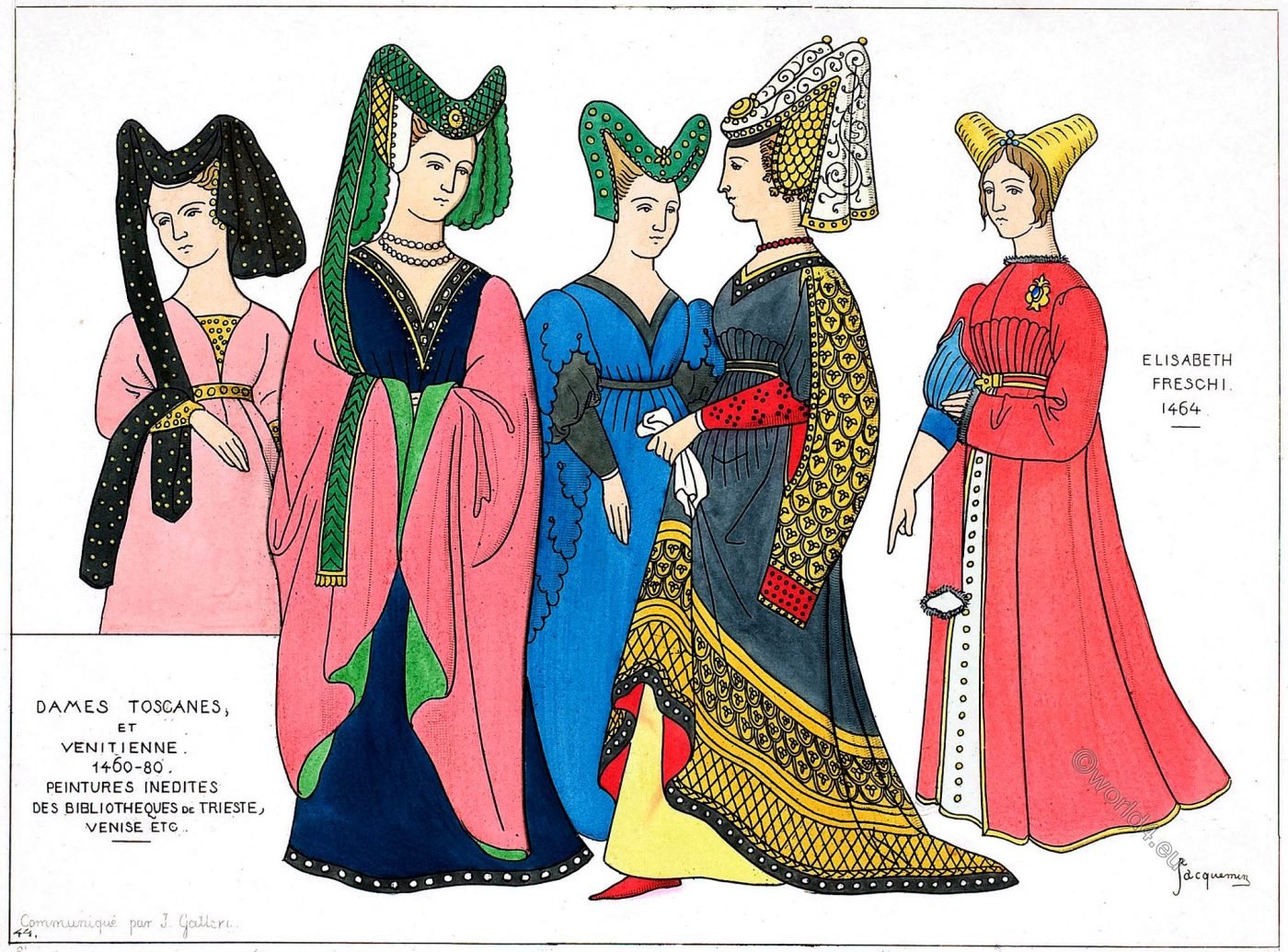
These dresses were usually worn without a girdle, but one was sometimes worn to assist in tucking up the dress and thus to correct its extreme length. Something quite new was the use of thick patterned silks and velvets, interwoven at times with silver or gold. As these materials were very heavy, and could be draped only in large folds, the cut of the dress had to be altered so that the stiffness of the material should not unduly interfere with freedom of movement.
Previous to any change in the cut, however, the long train was abandoned with these stiff dresses. Trains were worn only on great occasions, and were then borne by attendants. On the whole, the dresses were of the same shape as before. They were either close-fitting or wide all the way down. But both styles suffered some change in cut. The style that was close-fitting down to the hips was made open down the whole front; the two front wings were laced across the breast. The dress was usually left open from the waist down, although buttons and buttonholes were provided. The sleeves were as tight as possible, but very long—down to the tips of the fingers— and slashed longitudinally or across at the elbows, revealing a puff made of some delicate tissue disposed in folds.
There was also a change in the back. It was divided longitudinally, and shaped at the waist somewhat after the manner that had previously been restricted to the sides. The two edges were then sewn together, a perfectly close fit being thus produced. The gussets at the sides extended up to the hips; they were not now pointed at the top, but were blunted or rounded.
In order to secure a perfectly close fit at the back, the back was separated from the skirt. Both were shaped to some extent at the sides and again sewn together. The longitudinal folds that appeared in the dresses made of stiff material were ironed in with a warm rounded iron. Dresses that were wide from the shoulders down were cut in the same way as those made of thinner materials, but in their case the neck was low and the front slit extended to below the breast (Fig. 12.).








Other differences were due to the manner of making rather than to the cut. The back and front (each being made of suitable width by the insertion of gussets) were sewn together only on the shoulders. The sides were left open, either all the way or at least from the hips down. In both cases the unjoined parts were loosely laced together. If the dress was open from the armpit only the top half of the sleeves could be sewn to the dress.
This, however, was not always done with a continuous seam—the sleeves were sometimes attached to the dress by small buttons sewn on short distances apart, so as to reveal puffs of delicate tissue disposed in folds. The same delicate material peeped out from all the slashes—at the elbows, at the back of the upper arm and forearm, and sometimes also at the front of the upper sleeve. These slashes were held in place by small buttons or by loose lacing.
The sleeves were close-fitting on the forearm and gradually widened from the elbow to the shoulder. Sometimes, too, these dresses were worn with short sleeves reaching only to the elbows, and occasionally they had no sleeves at all. In both cases the similarly slashed sleeves of the dress worn beneath were visible. In these under-dresses the bodice and the skirt and sometimes even the sleeves were not infrequently made of different materials.
By Carl Kohler
Beginning at the end of the 14th Century, the Renaissance created a new type of man, triggering economic, scientific, technical, religious, social and cultural developments that are unique in history.
Source:
- A history of costume by Carl Kohler. EDITED AND AUGMENTED BY Edited and augmented by Emma von Sichart. New York, G. H. Watt 1930.
- On the history of costumes. Münchener Bilderbogen. Edited by Braun and Schneider 1860.
- Iconographie générale et méthodique du costume du IVe au XIXe siècle. Collection gravée à forte d’après des documents authentiques & inédits par Raphaël Jacquemin. Paris 1869.
- History of the costume in chronological development by Auguste Racinet. Edited by Adolf Rosenberg. Berlin 1888.
Continuing
Discover more from World4 Costume Culture History
Subscribe to get the latest posts sent to your email.

